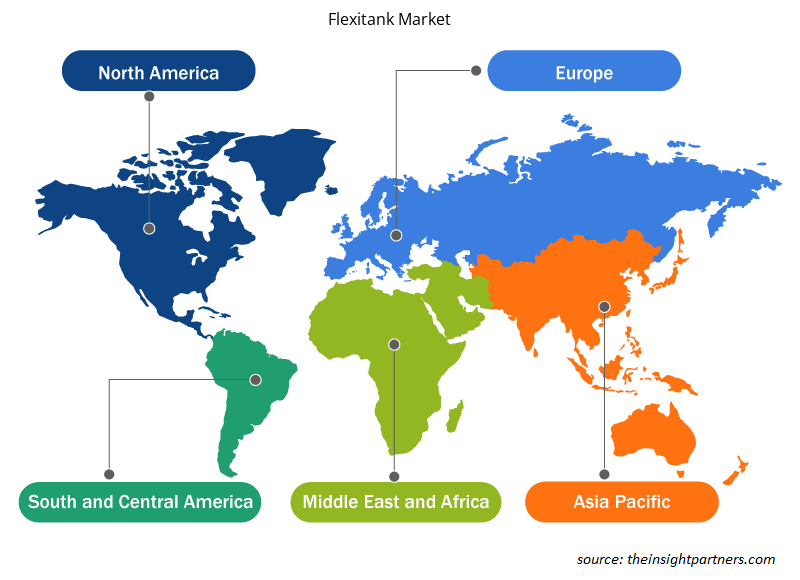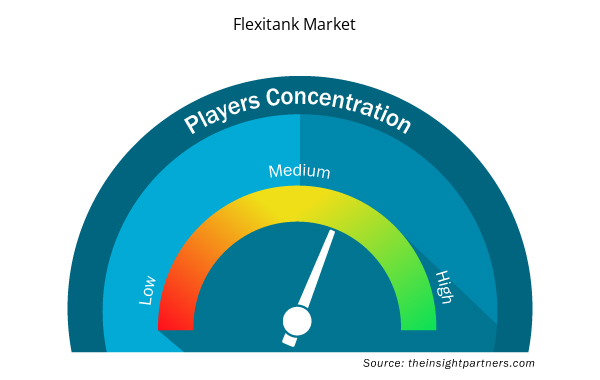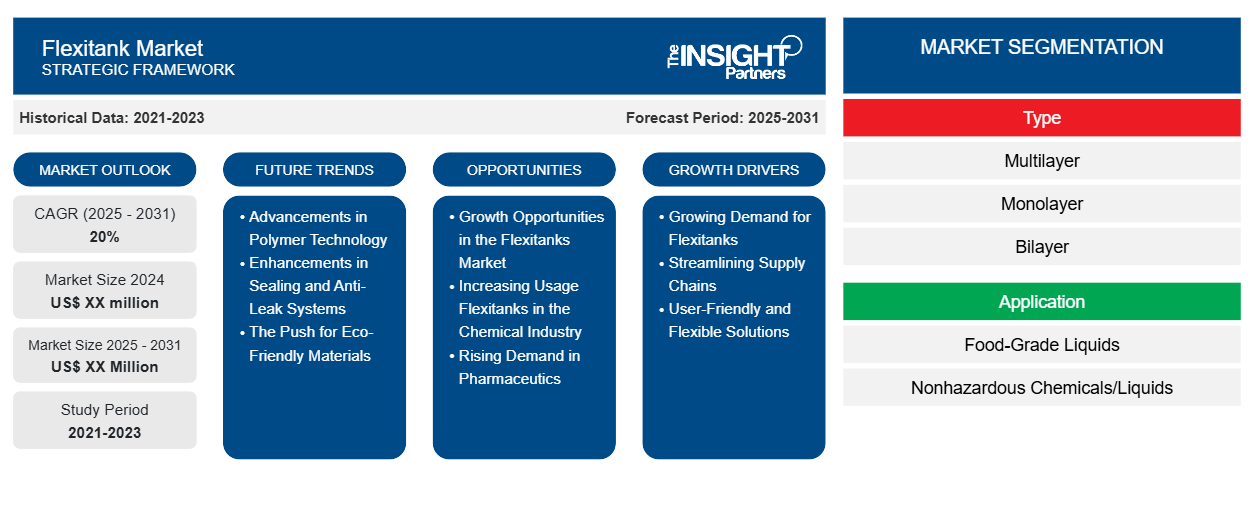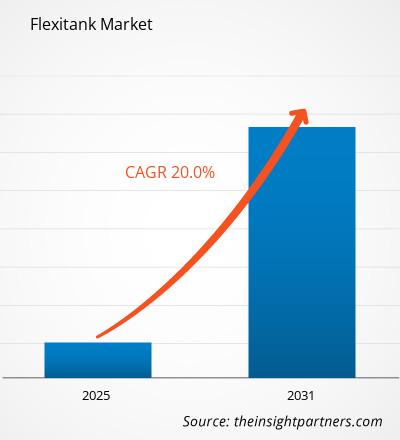Es wird erwartet, dass der Flexitank-Markt von 2024 bis 2031 eine durchschnittliche jährliche Wachstumsrate (CAGR) von 20 % verzeichnet und dass die Marktgröße von XX Millionen US-Dollar im Jahr 2024 auf XX Millionen US-Dollar im Jahr 2031 wächst.
Der Bericht präsentiert Analysen nach Typ (Mehrschicht, Einschicht und Zweischicht). Der Bericht ist nach Anwendung segmentiert (Lebensmittelflüssigkeiten, ungefährliche Chemikalien/Flüssigkeiten und andere). Die globale Analyse ist weiter auf regionaler Ebene und in die wichtigsten Länder unterteilt. Die Marktgröße und -prognose auf globaler, regionaler und Länderebene für alle wichtigen Marktsegmente werden im Rahmen des Berichts abgedeckt. Der Bericht bietet den Wert in USD für die oben genannte Analyse und die Segmente. Der Bericht bietet wichtige Statistiken zum Marktstatus der wichtigsten Marktteilnehmer und bietet Markttrends und -chancen.
Zweck des Berichts
Der Bericht Flexitank-Markt von The Insight Partners zielt darauf ab, die aktuelle Landschaft und das zukünftige Wachstum sowie die wichtigsten treibenden Faktoren, Herausforderungen und Chancen zu beschreiben. Dies wird verschiedenen Geschäftspartnern Einblicke geben, wie zum Beispiel:
- Technologieanbieter/-hersteller: Um die sich entwickelnde Marktdynamik zu verstehen und die potenziellen Wachstumschancen zu kennen, damit sie fundierte strategische Entscheidungen treffen können.
- Investoren: Durchführung einer umfassenden Trendanalyse hinsichtlich der Marktwachstumsrate, der finanziellen Marktprognosen und der Chancen entlang der Wertschöpfungskette.
- Regulierungsbehörden: Zur Regulierung von Richtlinien und Überwachungsaktivitäten auf dem Markt mit dem Ziel, Missbrauch zu minimieren, das Vertrauen der Anleger zu bewahren und die Integrität und Stabilität des Marktes aufrechtzuerhalten.
Flexitank-Marktsegmentierung
Typ
- Mehrschichtig
- Einschichtig
- Doppelschicht
Anwendung
- Flüssigkeiten in Lebensmittelqualität
- Ungefährliche Chemikalien/Flüssigkeiten
Passen Sie diesen Bericht Ihren Anforderungen an
Sie erhalten kostenlose Anpassungen an jedem Bericht, einschließlich Teilen dieses Berichts oder einer Analyse auf Länderebene, eines Excel-Datenpakets sowie tolle Angebote und Rabatte für Start-ups und Universitäten.
- Holen Sie sich die wichtigsten Markttrends aus diesem Bericht.Dieses KOSTENLOSE Beispiel umfasst eine Datenanalyse von Markttrends bis hin zu Schätzungen und Prognosen.
Wachstumstreiber auf dem Flexitank-Markt
- Wachsende Nachfrage nach Flexitanks: Flexitanks sind als kostengünstiges Mittel zum wirtschaftlichen Transport großer Flüssigkeitsmengen sehr gefragt. Der wachsende Bedarf an effizientem Flüssigkeitstransport treibt die Nachfrage auf dem Markt an. Die Lebensmittel- und Getränkeindustrie, die Chemie- und die Pharmaindustrie nutzen Flexitanks, da sie den Platz in den Behältern optimieren.
- Optimierung der Lieferketten: Mit der Ausweitung des internationalen Handels benötigen Unternehmen einfallsreiche Lösungen, um ihre Lieferkettenprozesse zu optimieren. Flexitanks ermöglichen den Transport größerer Flüssigkeitsmengen in herkömmlichen Versandbehältern. Diese Effizienz spart Versandkosten und trägt zur Verringerung der Umweltbelastung bei – Faktoren, die zu den Nachhaltigkeitszielen gehören könnten, die die meisten Unternehmen anstreben.
- Benutzerfreundliche und flexible Lösungen: Darüber hinaus sind Flexitanks aufgetaucht, da sie benutzerfreundlich und flexibel sind. Sie sind schneller zusammenzubauen und erfordern im Vergleich zu herkömmlichen Tankwagen weniger Reinigungsaufwand. Flexibilität ist bei diesem schnelllebigen Markt sowohl in Bezug auf Zeit als auch Ressourcen von entscheidender Bedeutung. Unternehmen streben nach Effizienz im Betrieb und bestellen daher weiterhin diese Lösungen.
Zukünftige Trends auf dem Flexitank-Markt
- Fortschritte in der Polymertechnologie: Innovationen in der Polymertechnologie sowie neue Durchbrüche in der Materialwissenschaft, die zu einem neuen Zeitalter robusterer, leichterer, aber dennoch zuverlässigerer und langlebigerer Materialien führen könnten, haben dazu geführt, dass sich die Verbraucher über eine höhere Sicherheit und Zuverlässigkeit der Flexitanks freuen können.
- Verbesserungen bei Dichtungs- und Antilecksystemen: Neue Designs, darunter bessere Dichtungs- und Antilecksysteme, tragen ebenfalls zum Wachstum des Marktes bei. Diese Merkmale verhindern Verunreinigungen und Leckagen, die für viele Hersteller und Logistikanbieter die größte Sorge darstellen. Unternehmen entscheiden sich jetzt für sichere Transportmethoden, und technologische Verbesserungen in diesen Bereichen werden immer wichtiger, um Industriestandards zu erfüllen.
- Der Vorstoß für umweltfreundliche Materialien: Darüber hinaus sind umweltfreundliche Materialien ein Forschungsbereich mit hohem Wachstum. Mit dem Fokus auf Umweltfreundlichkeit erforschen Hersteller von Flexitanks biologisch abbaubare oder recycelbare Materialien, da diese die Belastung durch Umweltschäden verringern und umweltbewusste Unternehmen anziehen können, um einen umweltfreundlichen Kundenstamm aufrechtzuerhalten.
Marktchancen für Flexitank
- Wachstumschancen im Flexitanks-Markt: Die Expansion in andere Branchen wie die Chemie-, Pharma- und Kosmetikbranche bietet großartige Wachstumschancen für den Flexitanks-Markt und ist nicht mehr länger auf die Lebensmittel- und Getränkebranche beschränkt, wo der Flexitanks-Markt ursprünglich hauptsächlich für den Transport von Flüssigkeiten genutzt wurde.
- Zunehmende Verwendung von Flexitanks in der chemischen Industrie: In der chemischen Industrie hat sich der Transport ungefährlicher Flüssigkeiten in Flexitanks in letzter Zeit als gängige Praxis etabliert und bietet eine kostengünstige Alternative zu herkömmlichen Tankwagen. Flexitanks sind vorgefertigte große Rohre aus flexiblem Kunststoff/PVC. Sie ermöglichen den Versand großer Mengen, ohne dass die Unversehrtheit des Produkts beeinträchtigt wird. Hersteller, die eine sehr effiziente Logistiklösung benötigen, finden sie attraktiv. Dies wäre ein gesunder Trend für Anwendungen, die ein viel breiteres Spektrum an flüssigen Ladungen umfassen.
- Steigende Nachfrage in der Pharmaindustrie: Auch die Pharmaindustrie gewinnt durch die Nutzung von Flexitanks zum Transport großer Flüssigkeitsmengen, darunter Impfstoffe und andere medizinische Bedarfsartikel, an Wert. Neben den Vorteilen der Nutzung von Flexitanks, wie der Begrenzung von Kontaminationsrisiken und der Gewährleistung der Produktqualität, besteht der Bedarf an sicheren und zuverlässigen Transportmethoden. Die Akzeptanz von Pharmazeutika wächst mit diesen aktuellen Entwicklungen, was für eine gute Nachfrage in der Zukunft sorgt.
Regionale Einblicke in den Flexitank-Markt
Die regionalen Trends und Faktoren, die den Flexitank-Markt im Prognosezeitraum beeinflussen, wurden von den Analysten von Insight Partners ausführlich erläutert. In diesem Abschnitt werden auch Flexitank-Marktsegmente und -Geografie in Nordamerika, Europa, im asiatisch-pazifischen Raum, im Nahen Osten und Afrika sowie in Süd- und Mittelamerika erörtert.

- Erhalten Sie regionale Daten zum Flexitank-Markt
Umfang des Flexitank-Marktberichts
| Berichtsattribut | Details |
|---|---|
| Marktgröße im Jahr 2024 | XX Millionen US-Dollar |
| Marktgröße bis 2031 | XX Millionen US-Dollar |
| Globale CAGR (2025 - 2031) | 20 % |
| Historische Daten | 2021-2023 |
| Prognosezeitraum | 2025–2031 |
| Abgedeckte Segmente | Nach Typ
|
| Abgedeckte Regionen und Länder | Nordamerika
|
| Marktführer und wichtige Unternehmensprofile |
|
Dichte der Flexitank-Marktakteure: Auswirkungen auf die Geschäftsdynamik verstehen
Der Flexitank-Markt wächst rasant, angetrieben durch die steigende Endverbrauchernachfrage aufgrund von Faktoren wie sich entwickelnden Verbraucherpräferenzen, technologischen Fortschritten und einem größeren Bewusstsein für die Vorteile des Produkts. Mit steigender Nachfrage erweitern Unternehmen ihr Angebot, entwickeln Innovationen, um die Bedürfnisse der Verbraucher zu erfüllen, und nutzen neue Trends, was das Marktwachstum weiter ankurbelt.
Die Marktteilnehmerdichte bezieht sich auf die Verteilung der Firmen oder Unternehmen, die in einem bestimmten Markt oder einer bestimmten Branche tätig sind. Sie gibt an, wie viele Wettbewerber (Marktteilnehmer) in einem bestimmten Marktraum im Verhältnis zu seiner Größe oder seinem gesamten Marktwert präsent sind.
Die wichtigsten auf dem Flexitank-Markt tätigen Unternehmen sind:
- Bornit
- Transport von flüssigen Massen
- Büscherhoff Packaging Solutions GmbH
- VERTRAUEN Sie auf Flexitanks
- Hillebrand
Haftungsausschluss : Die oben aufgeführten Unternehmen sind nicht in einer bestimmten Reihenfolge aufgeführt.

- Überblick über die wichtigsten Akteure auf dem Flexitank-Markt
Wichtige Verkaufsargumente
- Umfassende Abdeckung: Der Bericht deckt die Analyse der Produkte, Dienste, Typen und Endbenutzer des Flexitank-Marktes umfassend ab und bietet einen ganzheitlichen Überblick.
- Expertenanalyse: Der Bericht basiert auf dem umfassenden Verständnis von Branchenexperten und Analysten.
- Aktuelle Informationen: Der Bericht stellt durch die Abdeckung aktueller Informationen und Datentrends Geschäftsrelevanz sicher.
- Anpassungsoptionen: Dieser Bericht kann angepasst werden, um spezifische Kundenanforderungen zu erfüllen und die Geschäftsstrategien optimal anzupassen.
Der Forschungsbericht zum Flexitank-Markt kann daher dabei helfen, die Branchensituation und Wachstumsaussichten zu entschlüsseln und zu verstehen. Obwohl es einige berechtigte Bedenken geben kann, überwiegen die allgemeinen Vorteile dieses Berichts tendenziell die Nachteile.
- Historische Analyse (2 Jahre), Basisjahr, Prognose (7 Jahre) mit CAGR
- PEST- und SWOT-Analyse
- Marktgröße Wert/Volumen – Global, Regional, Land
- Branche und Wettbewerbsumfeld
- Excel-Datensatz



Report Coverage
Revenue forecast, Company Analysis, Industry landscape, Growth factors, and Trends

Segment Covered
This text is related
to segments covered.

Regional Scope
North America, Europe, Asia Pacific, Middle East & Africa, South & Central America

Country Scope
This text is related
to country scope.
Häufig gestellte Fragen
Technological advancements in flexitank materials and design is expected to be the key market trends.
Based on type, the multilayer segment is expected to witness the fastest growth during the forecast period
Based on geography, Asia Pacific held the largest share of the flexitank market as governments of various countries in Asia Pacific are concentrating on expanding exports, which is expected to provide lucrative opportunities to the market.
The growing demand for efficient liquid cargo transportation is driving the market growth.
Bornit; Bulk Liquid Transport; Büscherhoff Packaging Solutions GmbH; TRUST Flexitanks; Hillebrand; MY FlexiTank (MYF); Kricon Group; Qingdao LAF Packaging Co., Ltd.; Bulk Liquid Solutions; and Abrao Group are some of the key players operating in the flexitank market
The Flexitank Market is estimated to witness a CAGR of 20% from 2023 to 2031
The List of Companies
- Bornit
- Bulk Liquid Transport
- Büscherhoff Packaging Solutions GmbH
- TRUST Flexitanks
- Hillebrand
- MY FlexiTank (MYF)
- Kricon Group
- Qingdao LAF Packaging Co., Ltd.
- Bulk Liquid Solutions
- Abrao Group
The Insight Partners performs research in 4 major stages: Data Collection & Secondary Research, Primary Research, Data Analysis and Data Triangulation & Final Review.
- Data Collection and Secondary Research:
As a market research and consulting firm operating from a decade, we have published and advised several client across the globe. First step for any study will start with an assessment of currently available data and insights from existing reports. Further, historical and current market information is collected from Investor Presentations, Annual Reports, SEC Filings, etc., and other information related to company’s performance and market positioning are gathered from Paid Databases (Factiva, Hoovers, and Reuters) and various other publications available in public domain.
Several associations trade associates, technical forums, institutes, societies and organization are accessed to gain technical as well as market related insights through their publications such as research papers, blogs and press releases related to the studies are referred to get cues about the market. Further, white papers, journals, magazines, and other news articles published in last 3 years are scrutinized and analyzed to understand the current market trends.
- Primary Research:
The primarily interview analysis comprise of data obtained from industry participants interview and answers to survey questions gathered by in-house primary team.
For primary research, interviews are conducted with industry experts/CEOs/Marketing Managers/VPs/Subject Matter Experts from both demand and supply side to get a 360-degree view of the market. The primary team conducts several interviews based on the complexity of the markets to understand the various market trends and dynamics which makes research more credible and precise.
A typical research interview fulfils the following functions:
- Provides first-hand information on the market size, market trends, growth trends, competitive landscape, and outlook
- Validates and strengthens in-house secondary research findings
- Develops the analysis team’s expertise and market understanding
Primary research involves email interactions and telephone interviews for each market, category, segment, and sub-segment across geographies. The participants who typically take part in such a process include, but are not limited to:
- Industry participants: VPs, business development managers, market intelligence managers and national sales managers
- Outside experts: Valuation experts, research analysts and key opinion leaders specializing in the electronics and semiconductor industry.
Below is the breakup of our primary respondents by company, designation, and region:

Once we receive the confirmation from primary research sources or primary respondents, we finalize the base year market estimation and forecast the data as per the macroeconomic and microeconomic factors assessed during data collection.
- Data Analysis:
Once data is validated through both secondary as well as primary respondents, we finalize the market estimations by hypothesis formulation and factor analysis at regional and country level.
- Macro-Economic Factor Analysis:
We analyse macroeconomic indicators such the gross domestic product (GDP), increase in the demand for goods and services across industries, technological advancement, regional economic growth, governmental policies, the influence of COVID-19, PEST analysis, and other aspects. This analysis aids in setting benchmarks for various nations/regions and approximating market splits. Additionally, the general trend of the aforementioned components aid in determining the market's development possibilities.
- Country Level Data:
Various factors that are especially aligned to the country are taken into account to determine the market size for a certain area and country, including the presence of vendors, such as headquarters and offices, the country's GDP, demand patterns, and industry growth. To comprehend the market dynamics for the nation, a number of growth variables, inhibitors, application areas, and current market trends are researched. The aforementioned elements aid in determining the country's overall market's growth potential.
- Company Profile:
The “Table of Contents” is formulated by listing and analyzing more than 25 - 30 companies operating in the market ecosystem across geographies. However, we profile only 10 companies as a standard practice in our syndicate reports. These 10 companies comprise leading, emerging, and regional players. Nonetheless, our analysis is not restricted to the 10 listed companies, we also analyze other companies present in the market to develop a holistic view and understand the prevailing trends. The “Company Profiles” section in the report covers key facts, business description, products & services, financial information, SWOT analysis, and key developments. The financial information presented is extracted from the annual reports and official documents of the publicly listed companies. Upon collecting the information for the sections of respective companies, we verify them via various primary sources and then compile the data in respective company profiles. The company level information helps us in deriving the base number as well as in forecasting the market size.
- Developing Base Number:
Aggregation of sales statistics (2020-2022) and macro-economic factor, and other secondary and primary research insights are utilized to arrive at base number and related market shares for 2022. The data gaps are identified in this step and relevant market data is analyzed, collected from paid primary interviews or databases. On finalizing the base year market size, forecasts are developed on the basis of macro-economic, industry and market growth factors and company level analysis.
- Data Triangulation and Final Review:
The market findings and base year market size calculations are validated from supply as well as demand side. Demand side validations are based on macro-economic factor analysis and benchmarks for respective regions and countries. In case of supply side validations, revenues of major companies are estimated (in case not available) based on industry benchmark, approximate number of employees, product portfolio, and primary interviews revenues are gathered. Further revenue from target product/service segment is assessed to avoid overshooting of market statistics. In case of heavy deviations between supply and demand side values, all thes steps are repeated to achieve synchronization.
We follow an iterative model, wherein we share our research findings with Subject Matter Experts (SME’s) and Key Opinion Leaders (KOLs) until consensus view of the market is not formulated – this model negates any drastic deviation in the opinions of experts. Only validated and universally acceptable research findings are quoted in our reports.
We have important check points that we use to validate our research findings – which we call – data triangulation, where we validate the information, we generate from secondary sources with primary interviews and then we re-validate with our internal data bases and Subject matter experts. This comprehensive model enables us to deliver high quality, reliable data in shortest possible time.


 Holen Sie sich ein kostenloses Muster für diesen Bericht
Holen Sie sich ein kostenloses Muster für diesen Bericht